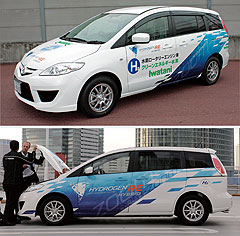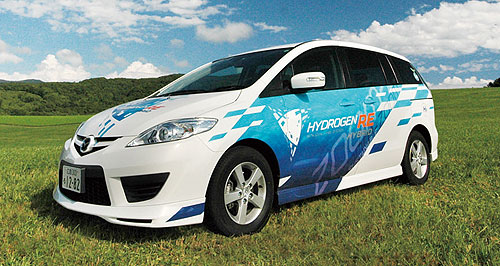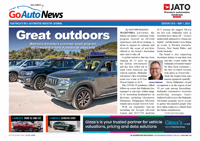Make / Model Search
Future models - Mazda - Premacy - Hydrogen REFirst drive: Hydrogen Premacy flexes Mazda muscleGas dream: Mazda's hydrogen hybrid Premacy HRE is put through its paces in Japan. Hydrogen Premacy hybrid a one-stop shop for all of Mazda’s future drive technologies26 Oct 2009 WITH the exception of one of its new ‘Sky’ engines, which will begin emerging in next-generation models from 2011, the Premacy Hydrogen RE combines all of Mazda’s big ideas into one rolling laboratory of future vehicle technologies. Available for lease in Japan since March and soon to be shipped to Norway as part of the joint-venture Hy-Nor hydrogen highway project, the hand-built Premacy HRE’s hydrogen-rotary engine is almost twice as efficient as Mazda’s first hydrogen lease vehicle, the RX-8 Hydrogen RE. While the three-year-old RX-8 can travel just 100km on 110 litres of hydrogen and produces just 80kW, the Premacy HRE delivers 40 per cent more power at 110kW and its 150-litre hydrogen tank ekes out a 200km driving range. Production-ready technologies like Mazda’s ‘i-stop’ idle-stop system and regenerative braking are fitted, but the most significant advance is a new hybrid drive system that could eventually work in tandem with Mazda’s next-generation Sky petrol and diesel engine range in a range of future production models. For now, the single-mode electric drive system, which Mazda says can also be adapted to power zero-emissions plug-in electric vehicles, works only with Mazda’s dual-fuel rotary engine in the Premacy HRE.  Unlike the Toyota Prius-style full two-mode parallel hybrid system that was co-developed with Ford for use in the US-only Escape and Tribute hybrid SUV twins, the internal combustion engine in the Premacy HRE’s series hybrid drivetrain, which was developed solely by Mazda, is not directly connected to its driving wheels. Unlike the Toyota Prius-style full two-mode parallel hybrid system that was co-developed with Ford for use in the US-only Escape and Tribute hybrid SUV twins, the internal combustion engine in the Premacy HRE’s series hybrid drivetrain, which was developed solely by Mazda, is not directly connected to its driving wheels.As with the upcoming Chevrolet/Holden Volt plug-in hybrid, which GM calls a “range-extending” electric vehicle, the Premacy HRE’s engine acts only as a power generator to charge its electric motor, which drives its front wheels at all times. Because the dual-fuel rotary-engined Premacy, which is known as the Mazda5 in the US, runs on both petrol and zero-emissions hydrogen, it is more environmentally friendly than both the Prius and Volt. While that likely makes it the world’s most advanced people-mover, the Premacy HRE’s smaller lithium-ion battery pack means it is not designed to drive on electric-only power for long distances like the Volt, which has an EV mode of about 65km. Like the Prius, it can start off under virtually silent, electric-only power before its engine kicks in to replenish the battery, but unlike the CVT-equipped Toyota the Premacy HRE’s rotary engine follows throttle inputs precisely, revving in unison with its driver to provide power on demand. Apart from being less disconcerting to drive than a CVT vehicle, Mazda says the feature is in line with its ‘Zoom-Zoom’ philosophy by offering traditional throttle response and addresses criticisms that conventional EVs are too quiet. However, while it is perhaps not quite as noisy as the almost identical rotary engine of the RX-8 HRE, there is no denying the hairy-chested induction note Premacy’s engine-generator can become tiresome when running on clean-burning hydrogen. Flick the dual-fuel rotary engine over the petrol mode, however, and not only does the Premacy HRE spring into life in terms of performance, it is also much quieter, smoother and more refined. As with the RX-8 HRE, hydrogen fuel consumption is high. We burned almost a quarter of the hybrid Premacy’s available hydrogen, which is stored in a pressurised 150-litre tank that replaces the third-row seats and leaves little room for luggage, during a 12km loop in downtown Yokohama outside Tokyo. Luckily, the Premacy HRE’s 25-litre petrol tank extends its hydrogen-only range well beyond the official figure of 200km. When the hydrogen is depleted, the Premacy switches automatically to run on petrol, reverting it to a CO2-producing vehicle with performance that’s almost identical to a standard Mazda people-mover. Apart from a higher second-row bench seat that also lacks foot room thanks to the large battery pack housed beneath it, this hydrogen-electric hybrid is almost identical to the standard Premacy sold in Japan (but not Australia). Like the RX-8 HRE, the driver’s side fuel filler is identical to a normal petrol cap, while the passenger-side hydrogen refuelling nozzle looks a bit like an LPG cylinder connection. Inside, a Prius-style display panel graphically shows when the inverter feeds power into the Li-Ion battery and when the battery and engine are powering the vehicle. Though there is no tacho, a readout shows if the vehicle is driving on hydrogen, petrol or electric power. The most obvious difference with the regular Premacy, however, is the fitment of plant-derived plastics and fabrics throughout the entire cabin. Mazda already employs some of these materials in its showroom vehicles as part of a push to reduce its dependence on oil, but the Premacy goes a number of steps further by employing “Biotechmaterial” branded surfaces for all but the car’s headlining. While the all-natural seat fabric feels reasonably soft and high-quality, the door and dashboard plastics are virtually indistinguishable from petroleum-based surfaces. Although it is far more advanced the RX-8 HRE, the hydrogen Premacy remains a work in progress that Mazda has no plans to mass-produce. The company should learn valuable lessons by leasing it to commercial customers in Japan and Norway, but until a more widespread hydrogen refuelling infrastructure exists it will continue to have limited public appeal. As the Japanese brand’s first series hybrid, however, the Premacy HRE’s electric drive system could easily be adapted to a number of mainstream Mazda models. Indeed, fitted with a higher-capacity Li-Ion battery, the system provides Mazda with the technology to rival both the Prius and the Volt, while its trademark dual-fuel rotary engine remains the zero-emissions icing on a potentially tasty cake.  Read moreAll future models Alfa Romeo Alfa Romeo Abarth Abarth Alpine Alpine Alpina Alpina Audi Audi Aston Martin Aston Martin BMW BMW Bentley Bentley Chery Chery Brabham Brabham Chrysler Chrysler Chevrolet Chevrolet Cupra Cupra Citroen Citroen DS DS Dodge Dodge Fiat Fiat Ferrari Ferrari Foton Foton Ford Ford Great Wall Great Wall FPV FPV Haval Haval GWM GWM Honda Honda Holden Holden Hummer Hummer HSV HSV Infiniti Infiniti Hyundai Hyundai Jaguar Jaguar Isuzu Isuzu Kia Kia Jeep Jeep Land Rover Land Rover Lamborghini Lamborghini Lexus Lexus LDV LDV Mahindra Mahindra Lotus Lotus Mazda Mazda Maserati Maserati Mercedes-AMG Mercedes-AMG McLaren McLaren MG MG Mercedes-Benz Mercedes-Benz Mitsubishi Mitsubishi Mini Mini Opel Opel Nissan Nissan Peugeot Peugeot Pagani Pagani Proton Proton Porsche Porsche Renault Renault Ram Ram Rover Rover Rolls-Royce Rolls-Royce Skoda Skoda Saab Saab SsangYong SsangYong Smart Smart Suzuki Suzuki Subaru Subaru Toyota Toyota Tesla Tesla Volvo VolvoMotor industry news |
Click to shareMazda modelsResearch Mazda All future models Alfa Romeo Alfa Romeo Abarth Abarth Alpine Alpine Alpina Alpina Audi Audi Aston Martin Aston Martin BMW BMW Bentley Bentley Chery Chery Brabham Brabham Chrysler Chrysler Chevrolet Chevrolet Cupra Cupra Citroen Citroen DS DS Dodge Dodge Fiat Fiat Ferrari Ferrari Foton Foton Ford Ford Great Wall Great Wall FPV FPV Haval Haval GWM GWM Honda Honda Holden Holden Hummer Hummer HSV HSV Infiniti Infiniti Hyundai Hyundai Jaguar Jaguar Isuzu Isuzu Kia Kia Jeep Jeep Land Rover Land Rover Lamborghini Lamborghini Lexus Lexus LDV LDV Mahindra Mahindra Lotus Lotus Mazda Mazda Maserati Maserati Mercedes-AMG Mercedes-AMG McLaren McLaren MG MG Mercedes-Benz Mercedes-Benz Mitsubishi Mitsubishi Mini Mini Opel Opel Nissan Nissan Peugeot Peugeot Pagani Pagani Proton Proton Porsche Porsche Renault Renault Ram Ram Rover Rover Rolls-Royce Rolls-Royce Skoda Skoda Saab Saab SsangYong SsangYong Smart Smart Suzuki Suzuki Subaru Subaru Toyota Toyota Tesla Tesla Volvo VolvoMotor industry news |










Facebook Twitter Instagram